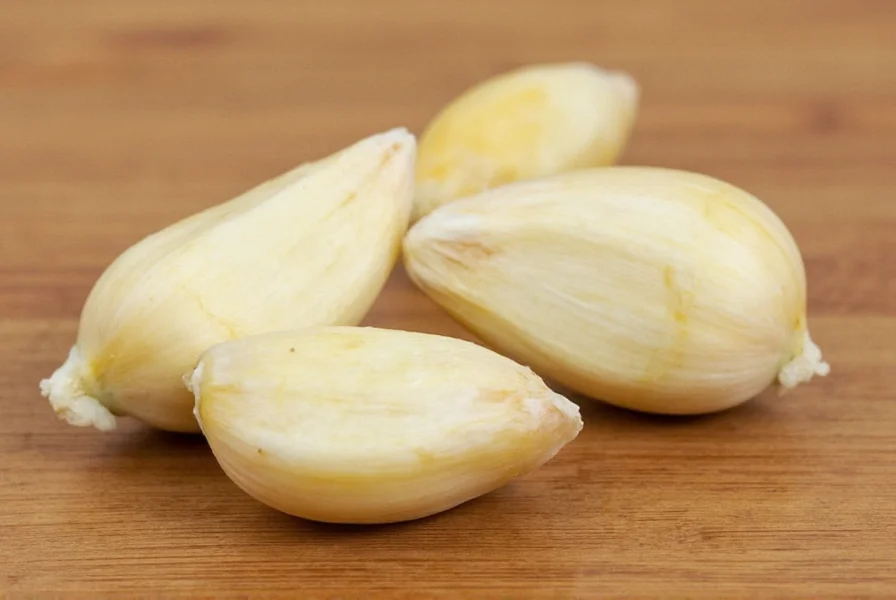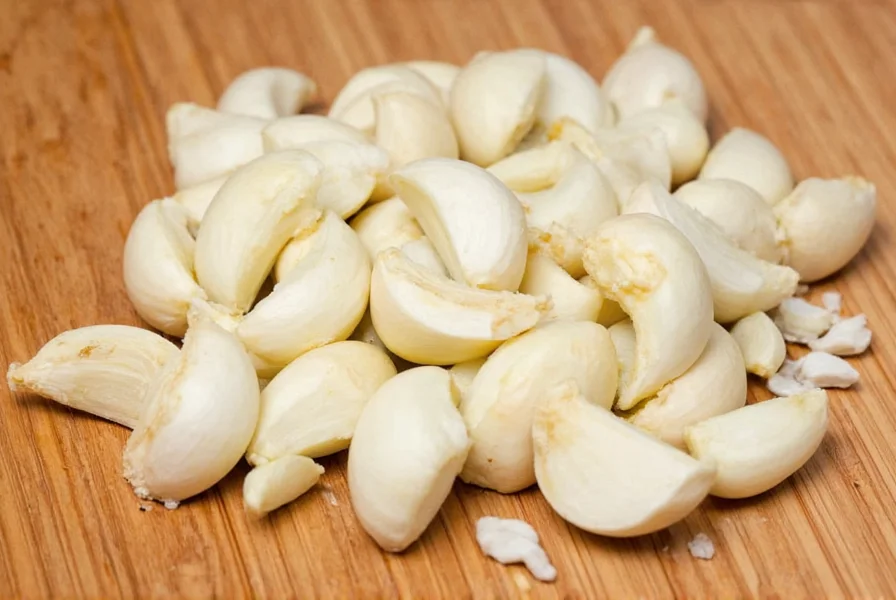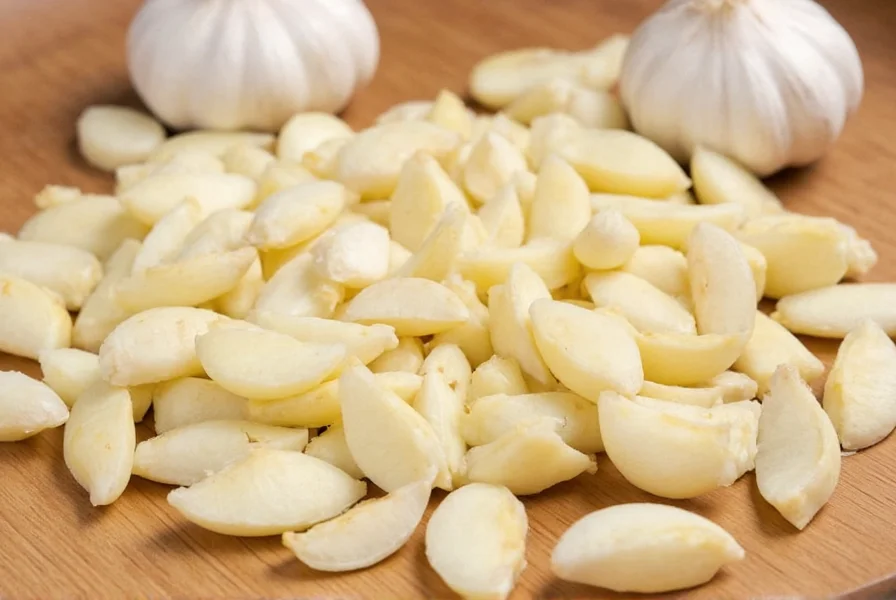Understanding garlic conversions is essential for consistent cooking results. While the standard conversion is straightforward, several factors affect the final measurement. Garlic clove size varies significantly between varieties and growing conditions, which directly impacts how much minced garlic you'll yield from whole cloves.
Garlic Clove Size Variations and Their Impact
Garlic comes in multiple varieties, each with different clove sizes:
| Garlic Type | Single Clove Weight | Minced Yield per Clove |
|---|---|---|
| Solo (Single Clove) | 15-30g | 1.5-2 tbsp |
| Softneck (Regular) | 3-7g | 1-1.5 tsp |
| Hardneck (Rocambole) | 5-10g | 1.5-2 tsp |
| Purple Stripe | 4-8g | 1.25-1.75 tsp |
When a recipe calls for "two cloves of garlic equals how much minced," most professional cookbooks assume medium-sized softneck cloves. For precise baking and delicate sauces, weighing your garlic provides the most accurate results. One medium clove typically weighs 4-6 grams before mincing.

Factors Affecting Garlic Conversion Accuracy
Several variables influence how much minced garlic you get from whole cloves:
- Mincing technique: Hand-minced garlic yields slightly less volume than food processor minced due to compression
- Moisture content: Freshly harvested garlic contains more moisture than cured garlic
- Cloves per head: Heads with more cloves generally have smaller individual cloves
- Preparation method: Smashing cloves before mincing releases more liquid, affecting volume
Practical Measurement Tips for Home Cooks
When converting whole garlic cloves to minced measurements, follow these professional kitchen practices:
- Use a kitchen scale for critical recipes (1 medium clove = 4-6g)
- For quick reference: 1 clove ≈ 1/2 tablespoon minced garlic
- When substituting jarred minced garlic, use 1/2 teaspoon per clove (contains preservatives that alter volume)
- For roasted garlic, 1 whole head yields approximately 2 tablespoons of paste
Understanding how two cloves of garlic equals how much minced prevents recipe failures. Many home cooks underestimate garlic volume, resulting in dishes that lack proper flavor development. Conversely, overestimating leads to overpowering garlic taste that dominates other ingredients.
Common Substitutions and Conversions
When you need to convert between different garlic forms, these equivalents help maintain recipe balance:
| Garlic Form | Equivalent to 1 Clove | Notes |
|---|---|---|
| Fresh minced | 1/2 tbsp (2.5 ml) | Standard measurement|
| Jarred minced | 1/2 tsp (2.5 ml) | Contains liquid preservatives|
| Garlic powder | 1/8 tsp (0.6 ml) | 3:1 fresh to powder ratio|
| Garlic salt | 1/4 tsp (1.25 ml) | Adjust other salt accordingly

Why Precise Garlic Measurement Matters
Garlic's flavor compounds activate when cells are broken during mincing. The surface area created by mincing affects how quickly these compounds develop. Two cloves of garlic equals how much minced directly impacts:
- Flavor intensity in finished dishes
- Chemical reactions during cooking
- Balance with other ingredients
- Storage stability of prepared dishes
Professional chefs consistently measure garlic rather than estimating because even small variations affect the final dish. When adapting family recipes or scaling up for entertaining, precise conversions ensure consistent results every time.
Frequently Asked Questions
How much minced garlic equals one whole clove?
One medium garlic clove yields approximately 1 teaspoon (5 ml) of minced garlic. Larger cloves may produce up to 1.5 teaspoons, while smaller cloves yield closer to 3/4 teaspoon. For precise baking and delicate sauces, weighing the clove (4-6 grams) provides the most accurate measurement.
Can I substitute jarred minced garlic for fresh cloves?
Yes, but with adjustments. Use 1/2 teaspoon of jarred minced garlic per fresh clove called for in your recipe. Jarred garlic contains preservatives and liquid that alter both volume and flavor intensity. For best results in sauces and dressings, sauté jarred garlic briefly to mellow its flavor before adding other ingredients.
Does roasting garlic change the measurement conversion?
Yes, roasting significantly changes garlic's volume and texture. One roasted garlic clove yields about 1/2 teaspoon of soft garlic paste, compared to 1 teaspoon of raw minced garlic. A whole roasted head typically produces 1.5-2 tablespoons of paste. Roasted garlic has a sweeter, milder flavor, so you may need slightly more than raw garlic for equivalent flavor impact.
How can I accurately measure very small garlic quantities?
For precise small measurements, use a digital kitchen scale set to grams. One teaspoon of minced garlic weighs approximately 5 grams. When working with partial cloves, mince the entire clove then measure the required portion. For recipes calling for "1/2 clove," use 1/4 teaspoon minced garlic. Microplane zesters provide consistent fine mince that's easier to measure accurately than hand-chopped garlic.
Why does my minced garlic measurement differ from recipe expectations?
Variations occur due to clove size differences, mincing technique, and moisture content. Commercial garlic varies seasonally and by origin. Hand-minced garlic typically yields less volume than food-processed garlic due to compression. For consistent results, standardize your technique: use the same knife and cutting board, mince to similar particle size, and measure immediately after preparation before moisture evaporates.











 浙公网安备
33010002000092号
浙公网安备
33010002000092号 浙B2-20120091-4
浙B2-20120091-4